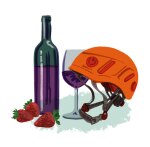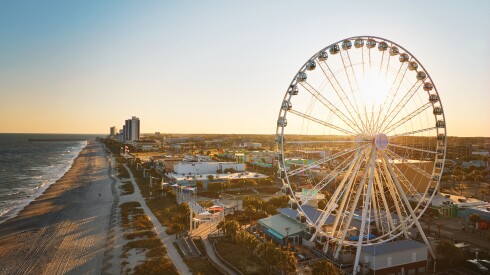I’ve loved France since I was seven and my aunt gifted me a poster of the Seine River at night. That poster, which hung on my wall for years, is still with me—stained, creased, and faded with time—because it was the first image that made me think of other places, other people, and other lives. That unknown filled me with wonder. I started chasing my travel dreams as a teen, eventually landing, in my mid-20s, in the Brittany region of northwest France.
There were long lunches—tomato tarts, neat green salads, pungent cheeses—capped with espressos in Rennes, the capital city, and weekends seeking salted caramel and tiny strawberries and oysters in coastal Cancale. I was astounded by the casual hyperlocality of it all, by families who spent generations handing down the legacy of cheese-making, baking, and winemaking.
This trip was the first time I learned to make the connection between the food I ate and the place it came from. So when I moved back to California after a year in France, I started working more with food. I got a job at a wine bar; I learned how to bake and cook.
But that was two decades ago, and the threads that tied me to France had begun to fray. My French fluency faded. And while food was still a big part of my life, I’d been feeling less and less connected to its origins.
Then I learned about the Vallée de la Gastronomie. Created in 2020 to celebrate the local offerings of more than 400 producers and small farmers, the roughly 385-mile trail begins in Burgundy and ends in Provence, passing through the country’s most iconic gastronomic regions. Traveling along the route seemed like a way to fast-track my reconnection with France, an opportunity to not only consume its iconic cheeses, seafood, wine, and pastries but also meet the people honoring the past and quite literally crafting the future. So I boarded a plane, six days of eating and drinking ahead of me.
When I walk into La Maison aux Mille Truffes in Marey-lès-Fussey, 35 minutes outside of Dijon, it’s clear that I’m in a sort of truffle Disneyland. There’s a truffle demonstration center, a truffle-focused restaurant, and a shop filled with truffle products that range from the expected (truffle-infused dried pasta) to the unappetizing-to-me (truffle ice cream). All of La Maison’s truffles come from within a 125-mile radius, and in a few minutes I’ll be hunting for them.
As my guide Nicolas Jeanroy preps his truffle gear, which looks like a collection of garden tools, his canine partner, Taïga, bounds up. At nine months old, she seems much too bouncy to excavate what is arguably the world’s most precious fungus, though Jeanroy—with a wink—assures me she only occasionally damages them as she learns the ropes.
Jeanroy tells me that only animals can smell truffles in the wild, as the delicacy grows up to a foot underground near tree roots; by law in France, hunters can use only pigs and dogs to find them.
“This breed is called—ta ta ta—Lagotto Romagnolo,” he trills in an over-the-top Italian accent, as a tribute to the mop-headed dog. This means that it’s finally Taïga’s time to shine. We troop out to La Maison’s large, wooded backyard, where birds chirp and sunlight filters through the leaves. Taïga bounces through the long grass like Pepé Le Pew in a Looney Tunes cartoon until, suddenly, she’s all business, making a beeline for a spot near one of the trees and pawing at the earth.
Jeanroy squats down, nudges Taïga aside, and starts digging with a cavadou—a sort of pick that resembles a very scary dental tool. He carefully scrapes around a truffle the size of a small apple, which he pulls out from the earth with a cinematic flourish. The truffle looks like . . . nothing much. Just a dirt-covered orb that only an animal could find. Yet it can be sold for more than $300 a pound.
A few hours later, this very truffle is turned into my lunch: It appears in a slab of truffle butter on bread and then in a creamy sauce blanketing delicate cod. For dessert, I use my own truffle “spade” (an elongated spoon) to dig through a layer of chocolate to access cream-filled black profiteroles. It’s a playful nod to truffle hunting, but one that sparks real reflection and appreciation: for the truffle, for Taïga, for my time learning more about where my food comes from.
Later that afternoon, 74 miles southwest of Marey-lès-Fussey, I stand in a field near Charolles, watching Charolais cows graze. I’ve never seen so much bovine personality. Wispy tufts of hair on the top of their heads give them kind of a punk look, and their fur is the color of Brie.

Maison Doucet is known for its all-beef tasting menu.
Illustration by Holly Wales
Meeting the cows is an essential part of the experience at Maison Doucet, a five-star Relais & Châteaux hotel with a Michelin-starred restaurant that’s known for its all-beef tasting menu. That means I’m looking at a future meal—one that will be prepared by chef Frédéric Doucet, who grew up in the hotel and now owns it and runs the restaurant.
Doucet says that he takes a humane approach to his cattle, moving the animals from field to field so they’re used to new places and aren’t as frightened when it’s time to end their lives. As a former vegetarian, I find it difficult to look my dinner in the eye, but the cows are seemingly content, ambling through sunlit golden fields as farmhands roll up bales of hay.
I ponder my own discomfort as I eat beef tartlets and tendon soup later that evening—and this overarching idea that we should see the fruits, the vegetables, and the animals we’ll consume before they get to our plate. After all, it’s easy to be disconnected from the process. Meat is often wrapped and divorced from its origins. Salads are bagged; fruit is precut. Convenience reigns. France is in no way immune to those influences, but in this moment, the connections between farm and table in France seem to have remained strong.
The next day, 190 miles south of Maison Doucet, I find myself 328 feet beneath the surface of the earth. I pick my way through La Grotte Saint-Marcel, a cave in Ardèche, feeling like a Ghostbuster in a full-body green suit. It’s dark and damp and smells like the sidewalk after a spring rain.
I shuffle along with just a tiny light attached to my helmet, illuminating stalactites dangling like earthen fingers and stalagmites stretching up as if to meet them. I’m not scared, exactly, but I feel unsettled, my senses scrambled. Then I hear Jézabel Janvre say, “We’ll taste two wines coming from the surface and two other wines coming from the cave. And we do the ‘speleoenology’ to show you the power of wine tasting in a cave.”
Janvre is a guide with Speleoenology, a company whose name is a mash-up of spelunking and winetasting; walking next to her is company cofounder Raphaël Pommier, who ages his wine in local caves.

Wine tasting in a cave heightens certain senses.
Illustration by Holly Wales
Our spelunking guide tells us that there are 40 miles of galleries to explore, and I’m surprised by how quickly I’ve become comfortable in this cave. I feel as though I could walk forever, but we are here to taste wine—and as Janvre and Pommier remind me, we must hike out afterward.
We settle into an enclave with natural stone benches, and Pommier and Janvre start pulling bottles out of their backpacks. First, they pour a local mineral water to cleanse the palate; then comes the initial round of wines. Before we taste, we must turn off our lights.
I’ve never been in such darkness. I can’t even see the outline of my hand. A fear grips me—that primal sense that something might be lurking in the pitch black, even though our spelunking guide assures us the cave contains no organic life. I feel as though I’ve been cleaved from my body, that there’s nothing left of me but my thoughts. This utter darkness, however, is crucial to the tasting.
Janvre hands me a glass of a red blend, and I’m immediately plunked back into my body and shocked by what I can smell. With my sight obscured, the aromas practically bounce out of the glass and into my nostrils. I can smell the wine—sun-warmed strawberries, violets, and an herb I can’t identify—even when I lower the glass to my waist, or to where I think my waist might be. Focusing on tasting also helps keep my fear in check: I’m not worrying about what might be hiding in the dark but rather zeroing in on the olfactory journey—an observation that doesn’t surprise Pommier. He’s found that most people want to immediately turn the lights back on, that they can’t stand the dark. But once they start tasting, they forget their fear.
“We could spend half an hour just tasting wine in the dark, because in fact we are not losing senses,” he says. “We’re still connected.”
Marseille, my final stop, is known for many things: seafood (thanks to its coastal location), size (the second-largest city in France), and boat-shaped cookies known as navettes.
According to legend, the cookies represent the ship that carried three important saints—Mary Magdalene, Martha, and Lazarus—to Provence more than 2,000 years ago. But don’t refer to them as a Provence cookie, says José Orsoni, the baker-owner of Les Navettes des Accoules, his family bakery. “They’re not Provençal,” he insists. “They’re Marseillais.”
Orsoni has salt-and-pepper hair and an exaggerated, slightly mischievous energy. I’ve arrived too late in the day to witness any baking—“You must come at 5 a.m. for that, not 5 p.m.!”—but he hands me three confections, including his navette, made of flour, sugar, butter, eggs, salt, and orange blossom water. It tastes light, divine. It is the kind of cookie I could eat a million of and believe to be a vaguely healthy thing.
Orsoni is closing for the day, so he invites me for a glass of wine in the small plaza next to the bakery. Lighting a cigarette, he tells me about the history of the area, about the tunnels beneath the city. Person after person comes by, shouting something to Orsoni. It feels fitting to end my trip here, with him, someone so passionate about culinary tradition. Our Provençal white wine arrives, and as we lift our glasses in a toast—“Santé! Santé!”—I tip my head back and drink it all in.











